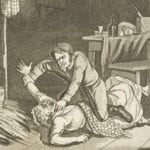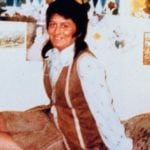 Humans
Humans  Humans
Humans  Movies and TV
Movies and TV The 10 Most Heartwarming Moments in Pixar Films
 Travel
Travel Top 10 Religious Architectural Marvels
 Creepy
Creepy 10 Haunted Places in Alabama
 History
History Top 10 Tragic Facts about England’s 9 Days Queen
 Food
Food 10 Weird Foods Inspired by Your Favorite Movies
 Religion
Religion 10 Mind-Blowing Claims and Messages Hidden in the Bible Code
 Facts
Facts 10 Things You Never Knew about the History of Gambling
 Weird Stuff
Weird Stuff 10 Cool and Creepy Facts about Collecting Tears
 Humans
Humans The Ten Most Lethal Gunslingers of the Old West
 Humans
Humans Ten Historic Men Who Deserve Way More Credit Than They Got
 Movies and TV
Movies and TV The 10 Most Heartwarming Moments in Pixar Films
 Travel
Travel Top 10 Religious Architectural Marvels
Who's Behind Listverse?

Jamie Frater
Head Editor
Jamie founded Listverse due to an insatiable desire to share fascinating, obscure, and bizarre facts. He has been a guest speaker on numerous national radio and television stations and is a five time published author.
More About Us Creepy
Creepy 10 Haunted Places in Alabama
 History
History Top 10 Tragic Facts about England’s 9 Days Queen
 Food
Food 10 Weird Foods Inspired by Your Favorite Movies
 Religion
Religion 10 Mind-Blowing Claims and Messages Hidden in the Bible Code
 Facts
Facts 10 Things You Never Knew about the History of Gambling
 Weird Stuff
Weird Stuff 10 Cool and Creepy Facts about Collecting Tears
 Humans
Humans The Ten Most Lethal Gunslingers of the Old West
10 Terrifying Small-Town Serial Killers
Rightly or wrongly, we still tend to think of small towns as a more innocent place. How could a murderer flourish in a place where everyone knows your name? But behind the comfortable facade of small-town America have lurked some very disturbed individuals.
WARNING: Some of the crimes discussed in this article are of an extremely disturbing nature.
10William Inmon

The strange case of William Inmon started to unfold in September 2009, in the rural town of Springerville, Arizona. The 21-year-old fled his home and ran two blocks to the local police station, where he told Chief Steve West that officers from neighboring St. Johns had a search warrant to look through his house. Inmon, who had perhaps watched too much crime fiction, thought that West wouldn’t like other cops invading his territory and hinted that he should probably run them out of town.
Instead, he invited Inmon to sit down and talk. Over the next four hours, Inmon basically told West his life story. Eventually, he admitted that the St. Johns’ police were looking through his home because he was involved in a murder. As West listened, Inmon confessed to killing 16-year-old Ricky Flores with a single shotgun blast, allegedly at the urging of Flores’s girlfriend’s father, who disapproved of his daughter’s relationship.
Weeks after confessing to the Flores killing, Inmon came clean about two other murders. The first came in April 2007, when he shot 72-year-old William “Stoney” McCarragher. A local rancher, McCarragher was known for carrying large amounts of cash and frequently hired local kids to do odd jobs for him. After his death, it was revealed that he had a record of sexual offenses under a different name. Inmon said that McCarragher had touched him inappropriately and claimed to have murdered him so he wouldn’t hurt anyone else.
His second victim was Daniel Achten, who was killed early in 2009. A deaf Vietnam veteran, dubbed “Hummer Dan” for his tuneless humming, Achten was found in a shallow grave near his house. Inmon claimed to have killed Achten because he was a drug addict who had shot his dog.
Although he admitted some guilt over the Flores murder, Inmon insisted it was his duty to cleanse the world of those he deemed undesirable, and said he would have killed others if he hadn’t been caught. After striking a deal with prosecutors, he was given a 24-year sentence.
9Dana Sue Gray

Canyon Lake is a gated community in California with a population of about 10,000. With shopping malls, a golf course, a man-made lake, and elegant residential homes, Canyon Lake seems like any other affluent American town—with the added bonus of fences and security guards to keep unwanted people out. But little did the people of Canyon Lake know that there was already a dangerous person living in their midst. Her name was Dana Sue Gray.
The first to be killed was 86-year-old Norma Davis, who was Gray’s step-grandmother. Her body was found on February 28, 1994, stabbed in the chest and the neck. She had been dead for two days. The next to die was June Roberts. Gray strangled her with a phone cord and repeatedly hammered her in the face with a wine bottle. She left her five-year-old stepson outside in the car while she committed the murder. When Roberts was dead, Gray took her credit cards and went on a shopping spree, including a meal of crab cakes and scampi, a $500 suede jacket, a pair of $161 earrings, and a $5.99 toy helicopter for her stepson.
After Roberts, Gray moved on to Lake Elsinore, where she attempted to strangle 57-year-old Dorinda Hawkins, who was working alone in an antique shop, leaving her for dead. Fortunately, Hawkins survived. Gray’s last victim, 87-year-old Dora Beebe, would not be so lucky after Gray knocked on her door to ask for directions. Once inside, she strangled the senior citizen and beat her to death with a clothes iron. Beebe’s credit card paid for a $1,000 mountain bike, some perfume, and a boogie board.
Hawkins was able to give the police a description of Gray, and the police soon tracked her down, finding Beebe’s credit card inside her house. Gray was arrested and eventually admitted to the murders of Roberts and Beebe and the attempted murder of Hawkins. She was never charged with the death of Norma Davis, but police are confident she was the murderer. She claimed the murders were based on an impulse to shop.
8Scott Williams

A road crew worker for the Department of Transportation, Scott Williams seemed content with an uneventful existence in Monroe, North Carolina. In fact, a local police officer would later comment that Williams seemed to have lived a normal life, “except on [the] three or four occasions” when he brutally raped and murdered local women.
His first victim was 37-year-old Sharon House Pressley in 1997. In 2000, he attacked an unidentified woman, but she survived. He killed again in 2004, when he claimed the life of 34-year-old Christina Outz Parker. His last victim was 46-year-old Sharon Tucker Stone in 2006.
All three murder victims were raped, shot in the head, and dismembered. Apparently, Williams wanted to cannibalize one of the bodies, but was disgusted with the smell of the meat after cooking it. Police were led to Williams after the bodies of Parker and Stone were found just a few miles from his house. DNA and ballistic evidence confirmed his guilt. He was given three life sentences in 2008.
7Lee Roy Martin

Early in 1968, the citizens of Gaffney, North Carolina were gripped by fear after two young women were abducted. Twenty-year-old Nancy Carol Parris disappeared on January 29 and 14-year-old Nancy Christine Rhinehart went missing nine days later. The day after Rhinehart’s disappearance, the editor of the local paper received a mysterious phone call. Telling the editor to take out three pieces of paper because he had three stories for him, the caller revealed where he could find the bodies of the two missing girls. He also confessed to the rape and murder of 32-year-old Annie Dedmond in 1967. Her husband had been convicted of the crime and was serving 18 years in prison at the time.
Four days later, the editor received another two phone calls warning of more murders to come. The next day, 15-year-old Opal Buckson went missing. But by this time, Gaffney and the surrounding townships were on high alert. Within an hour of Opal’s disappearance a search party was out looking for her. Sadly, her body was found stabbed to death, but witnesses saw a local man named Lee Roy Martin’s car in the woods where her body was found. Martin was arrested a short time later.
Dedmond’s husband was released from prison in February 1968. In May, Martin was convicted of all four murders and given a life sentence for each. On May 31, 1972, he was stabbed to death by his cellmate.
6Filiberto Hernandez

Between 2010 and 2013, five young women disappeared from the central Mexican town of Tamuin. Only one of their bodies was found. The others simply vanished.
The terrifying series of crimes started with the disappearance of 16-year-old Rosa Maria Sanchez in 2010. Thirteen-year-old Adriana Martinez was next to vanish, failing to make it home from school one day in 2011. Her dead body was later found. In 2013, three people went missing: nine-year old Dulce Jimena Reyes, 12-year-old Itzel Castillo, and 32-year-old Eliehoenai Chavez.
In 2014, the police detained a 43-year-old karate instructor named Filiberto Hernandez, who confessed to raping and murdering all five. As part of his confession, he gave the police directions to a field where he had buried his victims. The police were able to retrieve the bodies of Sanchez and Castillo, while the search for Reyes and Chavez continues.
5Kendall Francois

Between 1996 and 1998, eight prostitutes went missing in the town of Poughkeepsie, New York. Suspicion soon fell on an unemployed teacher’s aide named Kendall Francois, who lived with his parents and sister a short distance from Vassar College. The police were aware of Francois since local prostitutes had complained about his behavior in the past. He was interviewed and monitored, but there wasn’t enough evidence to charge him. At one point, the police even entered the family home, noting that it was full of garbage and smelled horrible. However, they couldn’t do an official search without a full warrant.
Francois remained on the loose until September 21, 1998, when he called a prostitute to his house and attempted to strangle her. Amazingly, he suddenly stopped and she was able to escape, flagging down a police car. He was interrogated and admitted to strangling the eight missing women, hiding their bodies in his attic.
Francois eventually received eight 25-year life sentences. His parents and sister weren’t charged with any crimes as they apparently didn’t know about the bodies in the attic. Francois told them that the smell was from a dead raccoon, which he was having problems removing.
Francois died from natural causes in prison on September 11, 2014 at the age of 43.
4The Jeff Davis Eight

Between May 2005 and June 2009, the people of Jefferson Davis Parish, Louisiana kept stumbling across bodies—eight in total. All were badly decomposed, to the point that it was difficult to determine a cause of death, but authorities came to suspect that the eight unexplained deaths might be the work of a serial killer. The bodies belonged to women aged between 17 and 30. All of them had been raised by their extended families in two small towns in the parish: Jennings, population 10,000, or Lake Arthur, which has a population of just about 3,000. The towns were so small that many of the victims knew each other and some were even related. All had drug problems and were involved in the sex trade, which is likely why they were targeted.
Many locals are angry with the sheriff’s department because of perceived sloppiness in investigating the cases, and there have been calls for Louisiana’s Attorney General to take over the investigation. There has even been speculation that the police department, long dogged by corruption allegations, may have conspired to conceal the murders. A Jeff Davis police officer named Jesse Ewing claims to possess audio tapes in which two female inmates accuse “higher-ranking officers” of being directly involved in the crimes. Ewing took the tapes to the FBI, who eventually handed them back to the local police. Ewing was subsequently charged with sexual misconduct and fired from the police department. To date, no one has been arrested in connection with the bodies.
The case attracted renewed attention in 2014, when fans of the show True Detective noticed similarities with the plot of the hit HBO series.
3Juan Corona

Born in Mexico, Juan Corona moved to the United States in the 1950s. In 1962, he was hired on as a labor contractor at some fruit orchards in Yuba City, California, which had a population of about 13,000. He eventually set up his own business, supplying seasonal laborers to the local farmers.
On May 19, 1971, a peach farmer named Goro Kagehiro noticed an unusual hole, about the size of a man, in his orchard near Yuba City. The next day, the hole had been filled in. Concerned, Kagehiro called the police, who discovered the mutilated body of Kenneth Whiteacre. Four days later, the bodies of nine more men were found in shallow graves in the orchards. All of them had been hacked or stabbed to death, most likely with a machete. A number of the men were found with their pants pulled down around their ankles, suggesting a sexual motive. Along with the bodies were two receipts signed by Juan Corona.
The receipts weren’t the first time Corona had been linked to a violent crime in Yuma City. In 1970, he had brutally attacked a gay man in the bathroom of a cafe owned by his half-brother. Corona also had a history of mental problems and had been hospitalized for schizophrenia in the past. He was first diagnosed following a major flood in 1956, after which he came to believe that he was the only survivor and everyone else was just a ghost.
Altogether, the police unearthed 25 bodies and eyewitnesses were able to link many of the victims to Corona. Circumstantial evidence was found in his home, including a possible murder weapons and ledgers containing the victims’ names. Corona was convicted in 1973, but the verdict was overturned in 1978 due to problems with his original lawyer. He was found guilty again in 1982 and received 25 concurrent life sentences.
At the time of the murders, Corona was the most prolific serial killer in the United States. He has applied for parole a number of times, the latest in 2011. All of the applications have been denied.
2David Parker Ray

Alleged serial killer David Parker Ray was based out of Truth or Consequences, New Mexico. Since the bodies have never been found, it’s unclear how many people Ray killed, but the victim count could be as high as 60.
Ray, along with his girlfriend Cindy Lea Hendy, would kidnap women and lock them in a storage trailer that he had spent almost $100,000 turning into a torture chamber. Known as “The Toy Box,” it was equipped with a number of S&M sex toys, surgical tools, and books on anatomy. Victims would be strapped to a gynecological chair in the middle of the trailer. In the corner, Ray placed a video screen so that they could see what he did while he tortured them.
A number of Ray’s known victims were residents of Truth or Consequences, but the town’s small population meant he most likely hunted elsewhere, before returning home with his victims. He was eventually arrested on March 22, 1999, when one of his torture victims escaped from the trailer and managed to get help. The police found plenty of evidence when they arrived on the scene, including video of a woman being tortured. Ray, his girlfriend, his daughter, and a friend named Dennis Roy Yancy were all arrested for kidnapping and the murder of a 22-year-old woman.
The first trial resulted in a hung jury. At his second trial, Ray agreed to take a 223-year sentence in exchange for a light sentence for his daughter, who eventually received just five years of probation. Hendy was given 36 years while Yancy was given a 15-year sentence.
Out of his 223-year sentence, Roy only spent three years in prison, dying of a heart attack at the age the age of 62.
1Donald Henry Gaskins

Donald Henry Gaskins, better known as “Pee Wee” because of his small stature, had been involved in serious crimes since he was a teenager. Before he was 18 he had participated in the gang rape of a friend’s sister (the friend was also involved) and attacked a young woman with an ax after breaking into her house. He was sent to a reform school, from which he escaped a number of times. He was finally released when he was 18.
He wouldn’t spend long on the outside, drifting in and out of prison until September 1969, when he started his killing spree. Gaskins had moved to Sumter, South Carolina, which had a population of about 25,000. There, he claimed he would abduct hitchhikers, holding them prisoner in order to rape, mutilate, and torture them. The victims would sometimes suffer for days before he murdered them. He also claimed to have committed acts of cannibalism, and even forced some of his victims to eat their own flesh. He called these murders his “coastal killings.”
In 1970, he started performing what he called his “serious murders.” These targeted people he knew, who often lived in Sumter. His victims included his 15-year-old niece and one of her friends. He also murdered a 20-year-old pregnant woman and her toddler son, drowning them in a pond behind his house.
In 1972, he moved to Prospect, South Carolina, which was even smaller than Sumter. He was well-known in the area, mostly because he drove a hearse and told people he used it to take dead bodies to his own personal cemetery. No one took him seriously—but if people had looked into the hearse, they would have seen that he was carrying shovels and handcuffs.
Gaskins was eventually arrested after asking a friend to get rid of a van he had used in a murder. The friend confessed to the police and Gaskins was soon given the death sentence, which was commuted to a life sentence after South Carolina dropped the death penalty in 1974.
On September 12, 1982, another incarcerated murderer, Rudolph Tyner, was killed when a radio exploded in his face. Investigators determined that Gaskins had rigged it to explode on the orders of Tony Cimo, whose parents had been killed by Tyner. By 1982, South Carolina had reinstated the death penalty, and Gaskins was sent to the electric chair on September 6, 1991.
Gaskins had 13 confirmed victims, but he claimed the real number was over 100.
Robert Grimminck is a Canadian crime-fiction writer. You can follow him on Facebook, on Twitter, or visit his website.


![10 Creepiest Photos Of Victims Taken By Serial Killers [DISTURBING] 10 Creepiest Photos Of Victims Taken By Serial Killers [DISTURBING]](https://listverse.com/wp-content/uploads/2018/09/Regina-Kay-Walters-featured-2-150x150.jpg)





